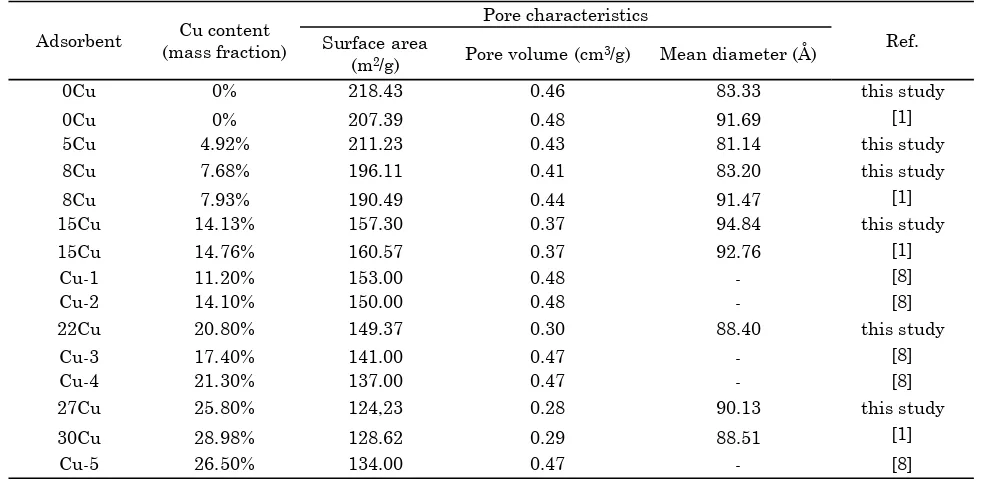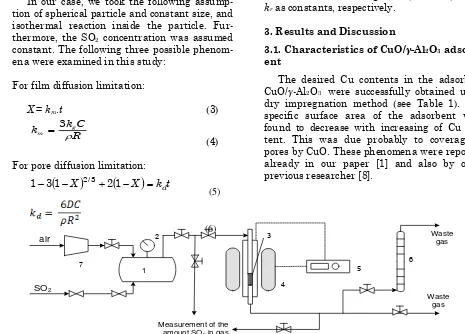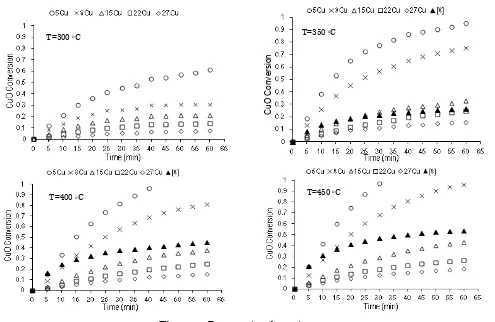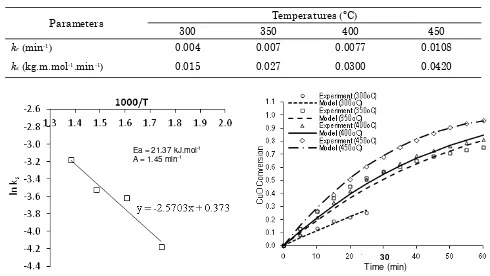Kinetic Study on the SO2 Adsorption using CuO/
γ
-Al2O3
Adsorbent
David Bahrin, S. Subagjo, Herri Susanto*
Department of Chemical Engineering, Institut Teknologi Bandung, Jln. Ganesa No. 10 Bandung 40132, Indonesia
Bulletin of Chemical Reaction Engineering & Catalysis, 11 (1), 2016, 93-99
Abstract
Adsorbent CuO/γ-Al2O3 for adsorption of SO2 were prepared by impregnating Cu(NO3)2.3H2O solution. Five types of adsorbent were obtained 5Cu (intended Cu concentration of 5%, actual of 4.92%, 8Cu (7.68%), 15Cu(14.13%), 22Cu (20.80%) and 27Cu (25.80%). For activity test, model gas containing SO2 with a concentration of about 0.757 mol.m-3 were passed through the bed of 1 gram adsorbent at a flow rate in the range of 1.4-1.8 mL.s-1. Adsorption of SO2 were carried out at a constant temperature of 300, 350, 400 or 450 °C. Increasing sulfur loadings (gram of sulfur per gram of adsorbent) were ob-served with increasing adsorption temperatures, but not with increasing Cu content in the adsorbent. Among those types, adsorbent of 8Cu was considered as the best with respect to the sulfur loading (3.71 g of sulfur per 100 g of adsorbent). Adsorbent 5Cu had actually a better sulfur loading, but it was suspected being contributed also by adsorption of SO2 on γ-Al2O3. The shrinking core model was used in the kinetic study of adsorption using 8Cu and with additional assumption of a spherical particle. Compared to film diffusion and pore diffusion controlling step models, the reaction rate limitation was the best to fit the experimental data. The reaction rate constant for this model at temperatures of 300, 350, 400 and 450 °C were 0.015, 0.027, 0.030 and 0.042 kg.m.mol-1.min-1, respectively. The activation energy was 21.37 kJ.mol-1 and the frequency factor was 1.45 min-1
.
Copyright © 2016 BCREC GROUP. All rights reservedKeywords: SO2 adsorption; CuO/γ-Al2O3 adsorbent; CuO conversion; shrinking core model
How to Cite: Bahrin, D., Subagjo, S., Susanto, H. (2016). Kinetic Study on the SO2 Adsorption using CuO/γ-Al2O3 Adsorbent. Bulletin of Chemical Reaction Engineering & Catalysis, 11 (1): 93-99. (doi:10.9767/bcrec.11.1.425.93-99)
Permalink/DOI: http://dx.doi.org/10.9767/bcrec.11.1.425.93-99
Available online at BCREC Website: http://bcrec.undip.ac.id
Research Article
1. Introduction
Increasing the use of low grade coal with a relatively high sulfur content for power plant will increase the emission SO2. This gas is poi-sonous that causes acid rains, corrosion at equipments and very harmful to human health. Depending on the excess air during the com-bustion, the concentration of SO2 in the flue
gas can be in the range of 294-747 mg.Nm-3. In-creasing consumption of coal with the high sul-fur content of more than 0.5%.wt (dry basis), the SO2 content may exceed the environmental standard of 750 mg.Nm-3 in Indonesia [1].
Conventional FGD (flue gas desulfurization) technologies, such as absorption using lime/ limestone slurry or sea water are claimed to have an efficiency of SO2 removal up to 99%. But these techniques discharge other forms of waste. So it has been considered since long time ago to develop a method to adsorb SO2, then desorp it as SO3, which may finally be * Corresponding Author.
E-mail: [email protected]
Telp: +62-22-2500989, Fax: +62-22-2501438
converted to H2SO4. The main reaction is pre-sented in Equation (1).
CuO(s) + SO2(g) + 1/2O2(g)→ CuSO4(s) (1)
For this technique, a regenerable adsorbent CuO/γ-Al2O3 has been proposed by many re-searchers [2-5]. Various CuO content in -Al2O3 were reported by previous researchers [6-10]. The effective CuO content on -Al2O3 was in the
Further explorations on preparation, char-acterization and activities test of CuO/-Al2O3
The shrinking core model was used to repre-sented the experimental data with the
follow-2.1. Preparation and characterization of adsorbent
Adsorbent CuO/-Al2O3 was prepared using the dry impregnation method with a solution of Cu(NO3)2.3H2O as a source of active site. The γ -Al2O3 support has the following pore properties: spesific surface area of 218.43 m2.g-1, pore vol-temperature of 400 °C for 8 h to obtained CuO on the support.
The impregnation might be carried out more than once to get desired CuO contents up to 30% by mass (see Table 1). Detailed procedure of the impregnation was reported in our previ-ous paper [1]. The CuO content in the adsorb-ent were analyzed using Atomic Absorption Spectroscopy (Varian Spectra AA 220). The pore properties of the adsorbent were analyzed using BET method (Nova 3200e Quanta Chrome).
2.2. Activity test of adsorbent
The activity tests of CuO/-Al2O3 were
con-Bulletin of Chemical Reaction Engineering & Catalysis, 11(1), 2016, 94
Table 1. Characteristics of adsorbent
ducted in an electrically heated tubular reactor (see Figure 1). Adsorptions were carried out for 60 minutes, at a constant temperature of 300, 350, 400 or 450 °C. The amount of adsorbent was 1.0 gram. The gas was a mixture of SO2 and air, having a SO2 concentration of about 0.757 mol.m-3. The gas flowrate was adjusted in the range of 1.4-1.8 mL.s-1. In order to get the progress of adsorption of SO2 on CuO, the solution of H2O2 was replaced with the fresh one every five minutes.
The amount of reacted CuOwas calculated from the removal of SO2 from the gas stream (see Equation (1)). Then, the conversion of CuO was calculated by Equation (2).
(2) 2.3. The shrinking core model
In our case, we took the following assump-tion of spherical particle and constant size, and isothermal reaction inside the particle. Fur-thermore, the SO2 concentration was assumed constant. The following three possible phenom-ena were examined in this study:
For film diffusion limitation:
X = km.t (3)
(4) For pore diffusion limitation:
(5)
For surface chemical reaction limitation:
(7)
(8) For chemical reaction limitation, the Arrhenius equation may be applied: temperature (K). Using an appropriate lineari-zation, the above each reaction rate equation can be drawn as a straight line, with km, kd and kr as constants, respectively.
3. Results and Discussion
3.1. Characteristics of CuO/γ-Al2O3 adsorb-ent pores by CuO. These phenomena were reported already in our paper [1] and also by other
Bulletin of Chemical Reaction Engineering & Catalysis, 11(1), 2016, 95
3.2. Sulfur Loading
The increase in CuO content in did not af-fect the maximum sulfur loading, or gram of sulfur per 100 gram of adsorbent (see Figure 2). On the other hand, the sulfur loadings were in-fluenced by the adsorption temperature, the higher temperature the higher loading. Unfor-tunately, the maximum sulfur loadings were far below the stoichiometric yield, and were more less the same as those obtained by by previous researcher [8]. This incomplete
utili-zation of CuO indicated that some active site of CuO could not be reached by SO2, asCuO were not evenly distributed and a possible formation of a multilayer CuO on the surface of pores [1, 13].
Progress in CuO conversions were measured for five types adsorbent: 5Cu, 8Cu, 15Cu, 22Cu and 27Cu (see Figure 3), including experimental data reported by [8]. Adsorbents with a lower CuO content had significantly a better CuO con-version. This confirmed the effectivity of CuO distribution on the internal surface, and the gas and solid reaction took place only on the top layer active site.
Unrealistic CuO conversions exceeding 100% were observed from the adsorbent 5Cu, at tem-peratures of 400 and 450 oC. These were proba-bly due to additional SO2 reaction with the sup-port, γ-Al2O3. Please note that CuO conversion was calculated from the decrease of SO2 concen-tration across the adsorbent bed. Meanwhile part of internal surface in the adsorbent 5Cu was not covered CuO yet. This phenomenon is also reported by previous researchers [4, 5, 7, 11, 12]. Probability of reaction between SO2 and Al2O3 had been checked using XRD analysis on adsorption of SO2 using original support γ-Al2O3 [1, 8].
Bulletin of Chemical Reaction Engineering & Catalysis, 11(1), 2016, 96
Figure 2. Maximum sulfur loading as a function of Cu content in adsorbent (see also Table 1)
Figure 3. Progress in adsorption test
T=400 oC T=450
oC
T=300 oC T=350
oC
C
u
O
C
o
n
v
e
rs
Bulletin of Chemical Reaction Engineering & Catalysis, 11(1), 2016, 97
3.3. Model validation
Although the sulfur loadings were far from the stoichiometry (Figure 2), the conversion rate already decreased towards zero (Figure 3). These lead to a hypothesis that the overall rate of reac-tion between SO2 and CuO was controlled either by pore diffusion or by surface reaction, not by film diffusion. As the above discussion, the ad-sorbent 8Cu was considered the best among five type adsorbents. So, its experimental data was used in the kinetic study.
With an additional assumption of particle di-ameter of 2 mm, the experimental data were fit-ted very well using the shrinking core model with surface reaction as controlling step (Figure 4, including the correlation coefficient). Blocking pore or covering active site of CuO by CuSO4 might explain the reason of this finding.
Further evaluation on the shrinking core model with reaction limitation resulted the reac-tion rate constant of kr and ks at various
tem-peratures for adsorbent 8Cu. Finally, the ki-netic parameters for surface reaction were found as follows: (a) activation energy: Ea = 21.37 kJ.mol-1; (b) frequency factor: A = 1.45 min-1.
The above activation energy was slightly lower than the common value for kinetic of re-action regime, i.e. in the range of 25-35 kcal.mol-1. Thus, the overall process in the ad-sorption of SO2 with CuO/γ-Al2O3 actually dic-tated not only by surface chemical reaction, but also by physical phenomena. The valida-tion of the model using the above kinetic pa-rameters was very satisfactory (Figure 6). 4. Conclusions
The CuO concentration in adsorbent af-fected significantly to the pore properties of adsorbent CuO/γ-Al2O3. Unfortunately, its in-crease did not enhance the sulfur loading, and even decreased the CuO conversion.
Adsorb-Figure 4. Fitting shrinking core models on experimental data of adsorption using 8Cu (c) chemical reaction limitation
(b) pore diffusion limitation (a) film diffusion limitation
Controlling step
Correlation coefficient (R2) 300
°C
350 °C
400 °C
450 °C (a) film diffusion 0.946 0.810 0.911 0.902 (b) pore diffusion 0.969 0.985 0.950 0.922 (c) chemical
reac-tion
Bulletin of Chemical Reaction Engineering & Catalysis, 11(1), 2016, 98
ent 8Cu was considered as the best. Adsorption process could be represented by shrinking core model with reaction limitation.
Acknowledgements
This research is a part of doctoral research in Chemical Engineering FTI-ITB. This re-search on development of regenerable adsorb-ent are financed by PT. Pupuk Sriwidjaja, Palembang.
References
[1] Yuono, Bahrin, D., Susanto, H. (2015). Preparation and Characterization of CuO/γ -Al2O3 for Adsorption of SO2 in Flue Gas.
Modern Applied Science, 9: 107-113.
[2] Yoo, K.S., Jeon, S.M., Kim, S.D., Park, S.B. (1996). Regeneration of Sulfated Alumina Support in CuO/-Al2O3 Sorbent by Hydrogen.
Industrial and Engineering Chemistry Research, 35: 1543-1549.
[3] Macken, C., Hodnett, B.K., Paparatto, G. (2000). Testing of the CuO/Al2O3
Catalyst-Sorbent in Extended Operation for the Simultaneous Removal of NOx and SO2 from
Flue Gases. Industrial and Engineering Chemistry Research, 39:3868-3874.
[4] Xie, G., Liu, Z., Zhu, Z., Liu, Q., Ma, J. (2003). Reductive Regeneration of Sufated CuO/Al2O3 Catalyst-Sorbent in Ammonia.
Applied Catalysis B: Environmental, 45: 213-221.
[5] Mathieu, Y., Tzanis, L., Soulard, M., Patarin, J., Vierling, M., Moliere, M. (2013). Adsorption of SOx by Oxide Materials: A
Review. Fuel Processing Technology, 114: 81-100.
[6] Flores, R., Rodas, A., Palma, C., Melendez, Y.I., Melendez X.S., Gonzalez, L.L (2008). Thermogravimetric Studies on the Effect of Support in Sorbent-Materials Applied to Flue Gas Desulfurization. Fuel, 87: 1115-1126.
[7] Wittayak un, J., Mahachano n, K., Grisdanurak, N. (2002). Adsorption of Sulfur Dioxide by Copper Oxide Supported on Alumina and Modernite. In Proceedings of Asian Pacific Confederation of Chemical Engineering (APCChE), Christchurch, New Zealand.
[8] Gavaskar, V.S., Abbasian, J. (2006). Dry Regenerable Metal Oxide Sorbents for SO2
Removal from Flue Gas. 1. Development and Evaluation of Copper Oxide Sorbents. Industrial and Engineering Chemistry Research, 45:5859-5869.
Figure 5. ln ks versus 1/T for adsorbent 8Cu (see Table 2, based on Equation (9))
Figure 6. Fitting chemical reaction limitation model to experiment data of adsorbent 8Cu Table 2. The value of kr and ks at various temperatures for adsorbent 8Cu (CSO2 = 0.757 mol.m-3 and ρadsorbent = 2911.6 kg.m-3)
Parameters Temperatures (°C)
300 350 400 450
kr (min-1) 0.004 0.007 0.0077 0.0108
ks (kg.m.mol-1.min-1) 0.015 0.027 0.0300 0.0420
Ea = 21.37 kJ.mol-1 A = 1.45 min-1
Bulletin of Chemical Reaction Engineering & Catalysis, 11(1), 2016, 99
[9] Centi, G., Passarini, N., Perathoner, S., Riva, A. (1992). Combined DeSOx/DeNOx Reaction
on a Copper on Alumina Sorbent-Catalyst. 1. Mechanism of SO2 Oxidation-Adsorption.
Industrial and Engineering Chemistry Research, 31: 1947-1955.
[10] Yoo, K.S., Kim, S.D., Park, S.B. (1994). Sulfation of Al2O3 in Flue Gas Desulfurization
by CuO/-Al2O3 Sorbent. Industrial and
Engineering Chemistry Research, 33: 1786-1791.
[11] Deng, S.G., Lin, Y.S. (1996). Synthesis, Stability, and Sulfation Properties of Sol-Gel-Derived Regeneratif Sorbents for Flue Gas Desulfurization. Industrial and Engineering Chemistry Research, 35: 1429-1437.
[12] Yu, Q.C., Zhang, S.C., Yang, B., Liu, D.C., Xu, B.Q., Ma, W.H. (2009). Preparation of Sup-ported Nano-Copper Oxide and its Sulfation Kinetics. Transaction of Nonferrous Metals Society of China, 19: 757-761.
[13] Yu, Q.C., Zhang, S.C., Yang, B. (2011). Dis-persion of Copper Oxide Supported on g-Alumina and its Sulfation Properties. Trans-action of Nonferrous Metals Society of China, 21: 2644-2648.
[14] Askari, Sima, Rouein, H., Nikazar, Manouchehr. (2008). Study and Kinetic Modeling of Direct Sulfation of Iranian Limestones by Sulfur Dioxide at High CO2
Partial Pressure. Iranian Journal of Chemistry and Chemical Engineering, 3: 45-50.
[15] Gbor, P.K., Jia., C.Q. (2004). Critical Evaluation of Coupling Particle Size Distribution with The Shrinking Core Model.
Chemical Engineering Science, 59: 1979-1987.
[16] Gavaskar, V.S., Abbasian, J. (2007). Dry Regenerable Metal Oxide Sorbents for SO2
Removal from Flue Gas. 2. Modeling of the Sulfation Reaction Involving Copper Oxide Sorbent. Industrial and Engineering Chemistry Research, 46:1161-1166.
[17] Bahrami, R., Ebrahim, H.A., Halladj, R. (2014). Application of Random Pore Model for SO2 removal Reaction by CuO. Process Safety
and Environmental Protection, 92: 938-947.
Selected and Revised Papers from The 2nd International Conference on Chemical and Material Engineering 2015
(ICCME 2015) (29-20 September, 2015, Semarang, Indonesia)




